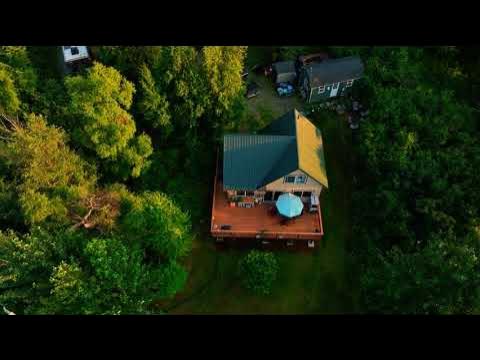
In most states, the weather is small talk. In Alaska, it’s infrastructure.
If you’ve lived in the Matanuska-Susitna Valley for any time, you’ve felt it: the Matanuska wind. It roars down the glacier valley at 100 miles per hour in subzero temperatures, rattling windows and shaking the ground. Around here, it’s not just a forecast; it’s a force that shapes how homes are built, insured, and even priced.
I’ve lived here my whole life, and I’ve learned that the wind isn’t background noise. It’s part of the economics of owning property in this valley.
Weather as a Line Item
When buyers look at homes in Palmer, Wasilla, or Sutton, they often focus on square footage or views. Locals look at something else first: wind exposure.
A well-sited home sheltered by hills or trees can mean lower heating costs, reduced insurance risk, and less wear on exteriors. However, properties sitting in open plains or near the mouth of the Matanuska Valley often face higher maintenance and energy bills.
That’s not theory; it’s experience. Over the decades, I’ve seen buyers adjust their offers based on how a property weathers the wind. Homes built right and placed right hold their value better.
If you’re comparing properties, add “wind protection” to your checklist. A little local insight can save you thousands over time.
The Hidden Cost of the Elements
Wind is only part of the story. The “Kick wind,” sometimes called the Pineapple Express, brings warm Pacific air that can swing temperatures from subzero to the 40s in a single day. That thaw-freeze cycle wreaks havoc on driveways, roads, and siding.
And when those winds pick up glacial silt from the Valley floor, the air can turn to dust, coating homes, cars, and crawl spaces. That’s not something you’ll find in a listing description, but it’s a real part of life here.
These local factors contribute to Alaska’s higher home insurance costs. Many carriers price policies differently in wind zones or decline coverage near erosion-prone rivers. Earthquake coverage is available but often expensive, so a surprising number of Alaskans go without it.
When budgeting for a Valley home, include maintenance and insurance in the long-term equation. Alaska rewards the prepared homeowner.
Building for the Conditions
We build homes in the Valley with weather in mind, and that’s one of the strengths of the local market. Foundations are insulated, rooflines are steep, and we use materials that withstand freeze-thaw cycles.
Still, not every home is created equal. Older homes may have insulation gaps or exposed lines, while newer homes comply with modern wind-load and energy-efficiency standards. Buyers who understand that difference can see long-term savings in both comfort and maintenance.
If you’re comparing properties, it’s worth asking one key question: “How does this home handle the Matanuska wind?”
If you’d like to know how a specific home stands up to the elements, reach out. Our team would be happy to review its build quality, siting, and long-term maintenance outlook with you.
The Wind Test in Action
A few winters ago, a young couple from Anchorage bought a house just east of Palmer. It sat on open land with sweeping mountain views but no windbreak. Within the first year, they learned how quickly the Matanuska can find weak spots. Their front door froze shut twice, and the siding peeled along the west wall.
Across the road, a similar home tucked behind a small spruce grove stayed warmer and quieter all winter. The owners burned less fuel and spent less time on repairs. By the next spring, their property had appraised higher.
In Alaska, “location” includes the landscape’s shape and shelter. A few trees or a gentle hill can make a major difference.
Why This Matters to the Market
The Valley’s unique climate means real estate values reflect more than supply and demand. They also reflect resilience. Homes that stand up to Alaska’s weather tend to sell faster and hold value longer.
That’s why seasoned buyers look for smart design and good placement, not just granite countertops. When weather shapes the market, the best investment is preparation.
FAQs About How Weather Shapes the Local Real Estate Market
1. What areas of the Mat-Su Valley experience the strongest Matanuska wind?
The corridor between Palmer and Sutton typically sees the highest gusts, especially near open valleys. Wasilla and Big Lake are less exposed, though they still see strong winter winds.
2. Can landscaping reduce wind exposure?
Yes. Natural windbreaks like spruce trees, berms, and fences can dramatically reduce gust speeds. It’s a worthwhile investment for long-term comfort and lower heating costs.
3. How does wind exposure affect home insurance rates?
Insurers often factor in wind zones and local loss history. In high-wind areas, deductibles may be higher, or coverage may exclude certain types of storm damage.
4. Are newer homes better equipped for Alaska’s weather?
In most cases. Modern codes require stronger framing, sealed insulation, and energy-efficient materials. Older homes can also perform well if they’ve been upgraded and maintained.
5. What’s the best way to identify a well-sheltered property?
Visit the site on a windy day or ask locals. Even a short walk can reveal whether a property is in a wind corridor or behind a natural barrier.
6. Does weather affect resale value?
Absolutely. Homes proven to handle the Matanuska wind and cold winters tend to attract more buyers and maintain stronger resale prices.
7. How can I prepare my current home for winter winds?
Seal gaps, inspect roofing and siding, and secure outdoor items. A fall preparation checklist can prevent costly midwinter surprises.
8. Should I consider the Matanuska wind when listing my home?
Yes. Highlight wind-resistant upgrades and sheltered siting. Buyers familiar with the Valley will appreciate that insight.
Navigate the Market With Weather in Mind
The Matanuska wind isn’t just a weather quirk; it’s a market factor. It affects how we build, insure, and value homes in the Valley. Most folks don’t realize until they’ve lived here that our real estate market is shaped as much by geography as by economics. The wind teaches you to respect both.
Are you looking to buy a home in Alaska? The Valley Market Team understands how weather and landscape can impact homeowners. Reach out now for guidance from experienced professionals.



